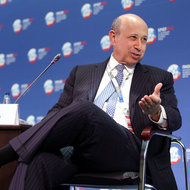Mr. Putin’s proposal to dip into the country’s pension reserves for loans of up to $43.5 billion for three big infrastructure projects provoked an immediate debate among some of Russia’s top financial minds. It also brought warnings from financial experts who said that it might produce a burst of inflation, and that what the Russian economy needed most was deep structural change, to diversify from oil and gas and to build investor confidence.
Mr. Putin, now in his 13th year as Russia’s political leader, made the stimulus plan the centerpiece of his speech at an annual economic forum here that serves as a gathering of the country’s top financial officials, business leaders and foreign investors. Slowing growth has been the obsessive topic this year.
In his speech, Mr. Putin said Russia would distribute the reserves as loans to modernize the storied Trans-Siberian Railway, which runs between Moscow and Vladivostok in the Far East; to construct a 500-mile high-speed rail line between Moscow and Kazan, the capital of the Tatarstan region; and to build a superhighway ringing Moscow.
“Our key challenge in the coming years is to remove many infrastructure constraints that literally stifle our country and prevent unlocking the potential of entire regions,” Mr. Putin said. “Investors are hugely interested in infrastructure projects, especially if the state is ready to provide guarantees, minimize the risks and act as a co-investor.”
The Russian economy has been strong in recent years, functioning almost at full capacity, largely because of high energy prices, which helped build up the country’s reserve funds. But with nearly full employment, new government spending is more likely to cause wage inflation than to create new jobs, experts say. Instead, they add, Russia needs to review manufacturing, create new industries and attract foreign capital.
While not the headline measure in Mr. Putin’s plan, the amnesty proposal was by far the most surprising item. It was the brainchild of Mr. Putin’s business ombudsman, Boris Titov, who has championed it as a means to improve the business climate.
“The period that just passed was not the best for defenders of property rights,” Mr. Titov said last week in an interview.
In 2000, when Mr. Putin came to power, the government re-examined many of the early post-Soviet privatizations, which were widely regarded as fraudulent, and later imprisoned the richest man in Russia at the time, Mikhail B. Khodorkovsky, on charges of tax evasion and fraud that many critics said were trumped up.
Taking a cue, police and Federal Security Service officers set about seizing businesses large and small throughout Russia from unpopular or unlucky businessmen, and often, in an Orwellian manner, emerging as the owners themselves.
In fact, police officers who seize businesses are common enough in Russia to have earned the nickname “werewolves in epaulets.”
The intention of the amnesty plan is to free thousands of run-of-the-mill businessmen caught up in this turmoil, while avoiding the high-profile and politically tinged cases, like those of Mr. Khodorkovsky, who is not expected to be freed.
Mr. Titov said that 110,000 people were serving prison time for economic crimes, and that 2,500 others were in pretrial detention. The draft of the amnesty bill, Mr. Titov said, covers 13,000 of them.
“This initiative will on the whole strengthen the trust of citizens” in the business community, Mr. Putin said in his speech. “I am certain the development of the state is possible only under conditions of respect for private property, to the values of economic freedom and the work and success of entrepreneurs.”
More broadly, though, the intention of Mr. Putin’s amnesty, Mr. Titov said, is to signal to the business community an easing police pressure. It is, he said, “a very positive, a very good signal for Russia, and that is important as in Russia. We don’t often have good signals.”

Article source: http://www.nytimes.com/2013/06/22/world/europe/russia-to-tap-reserve-funds-for-infrastructure-projects.html?partner=rss&emc=rss
